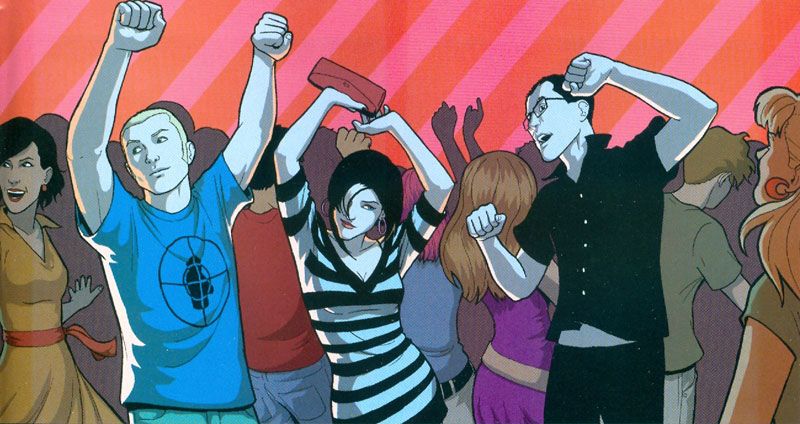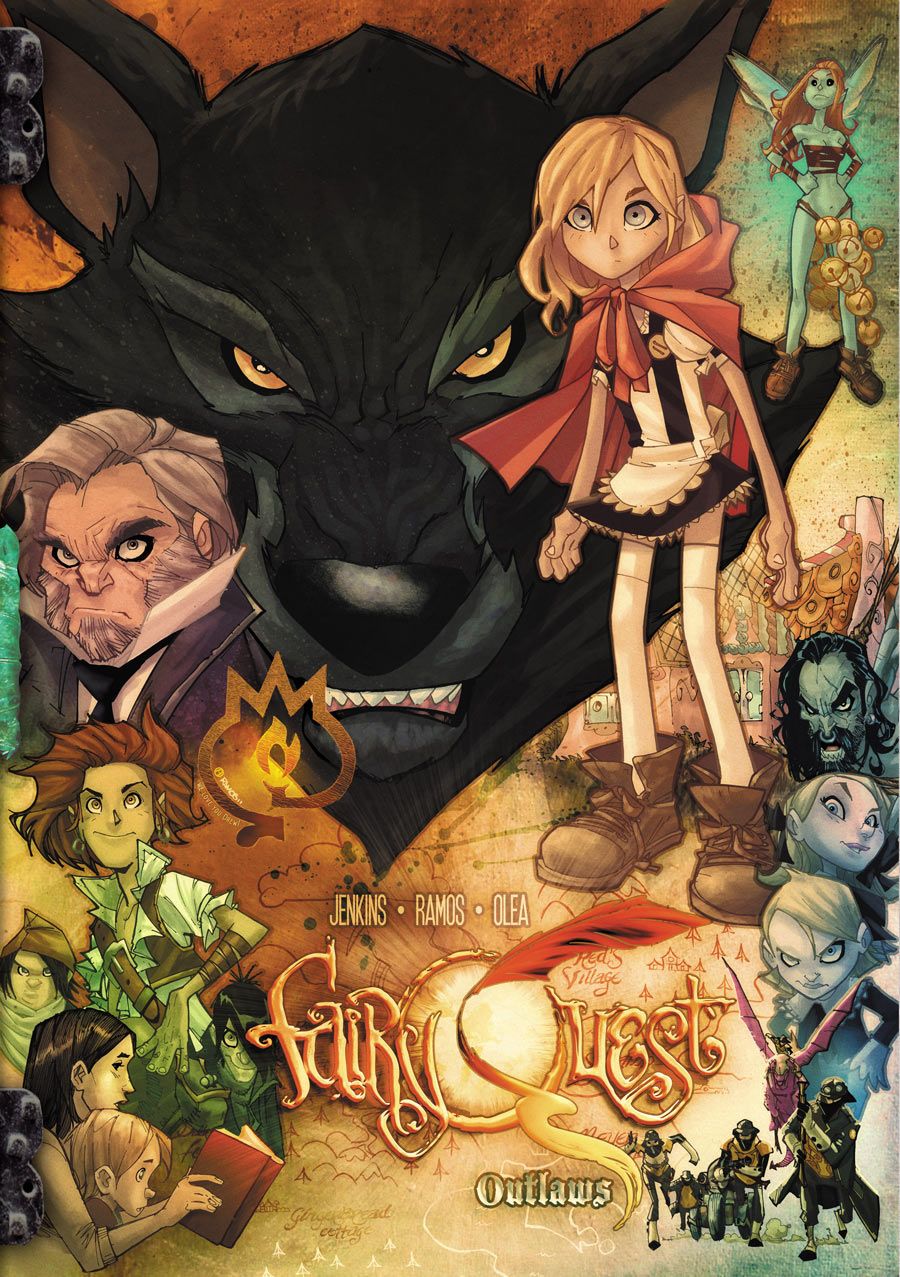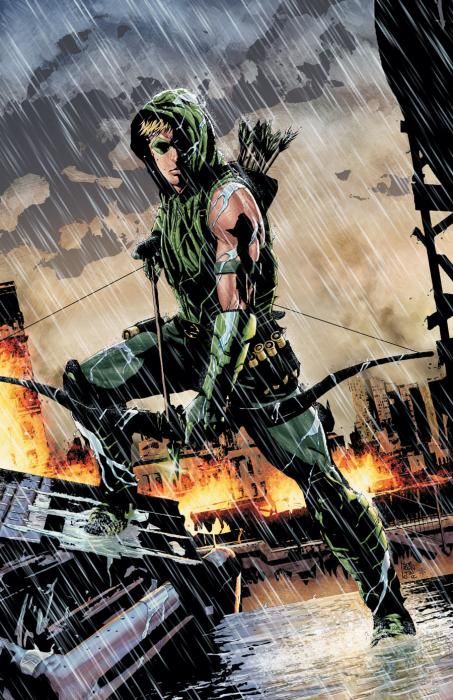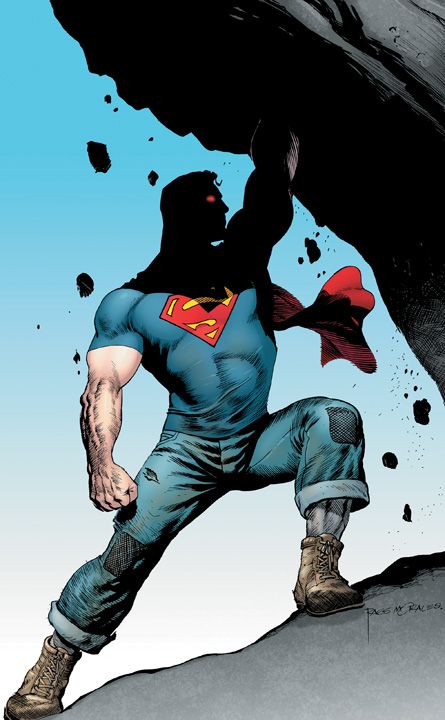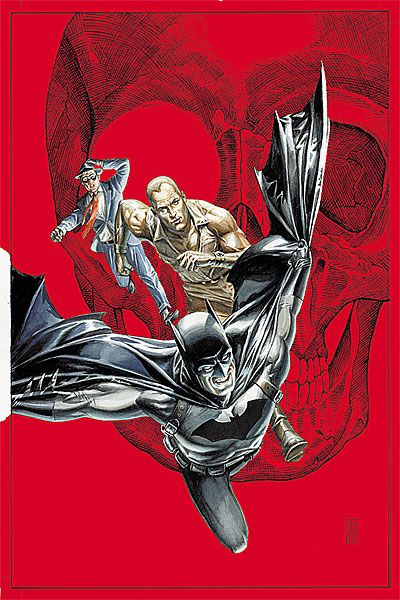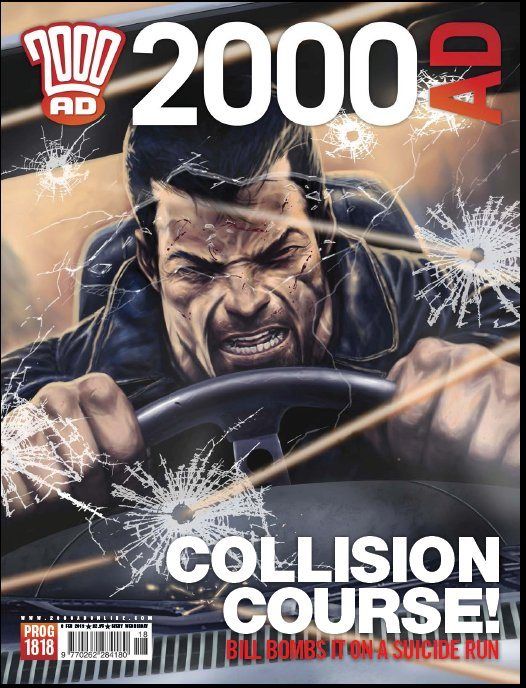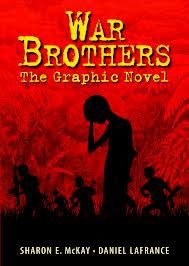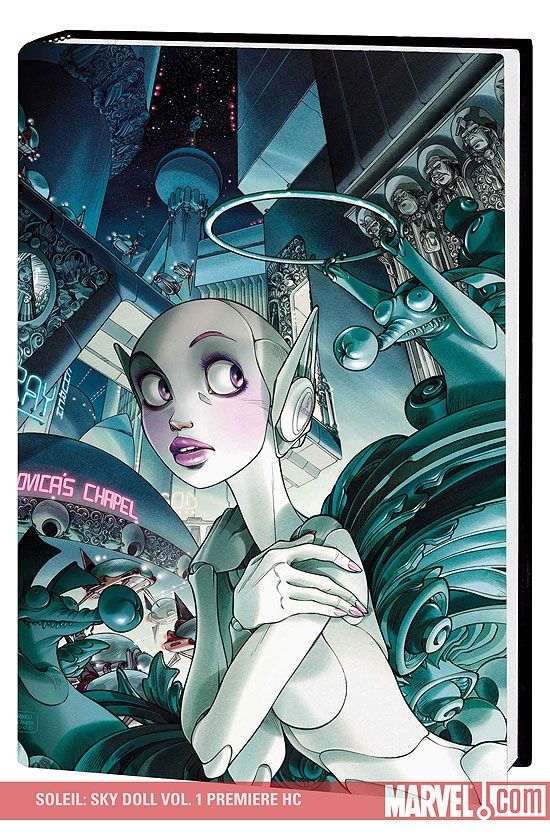Welcome to What Are You Reading?, where the Robot 6 crew shares their picks for who we think should play a young Han Solo. Of course, we unanimously chose Nathan Fillion, so instead we'll talk about what comics we've been reading. Joining us today is special guest Tim Lattie, the creator of Night Stars. Tim is currently running a Kickstarter to raise funds to publish it, so head over there and check it out.
To see what Tim and the Robot 6 crew have been reading, click below.
*****
Michael May
I was worried after the first few pages of Paul Jenkins and Humberto Ramos' Fairy Quest. I've been eager to read it since it was announced, but the opening page of a mother reading "Little Red Riding Hood" to her young son - followed by a straightforward (though great-looking) account of that story - was uncomfortably familiar. To my delight, that turns out to be exactly the point. The fairy tale characters in Jenkins and Ramos' world are locked into a Groundhog Day-like repetition of events and forbidden from deviation by the tyrant Grimm and his powerful squad of enforcers. Naturally, some of the characters are beginning to resent this and hold secret meetings to organize.
The comic becomes meta quickly. I read stories like this precisely because I want a different spin on familiar tales, so the more time Jenkins spends on the traditional versions (or just talking about the traditional versions) the more bored and impatient I get. Which means that when a couple of characters finally break free and go their own way, I'm totally on board with their not only escaping Grimm, but freeing as many of their fellow fairies as possible. Meaning that I'll be back for issue #2.
I didn't mention Humberto Ramos a lot in those two paragraphs, but he's the primary reason I was interested in Fairy Quest in the first place. As I work on whittling down my monthly reading list to a manageable level, I'm paying closer attention to art than I have been. Traditionally, I'm a writing guy. If I like the story and the art isn't actively offensive, I usually keep reading. I'm learning to be more discriminating about the drawings now though, and Humberto Ramos' pleasant and playful caricatures make Fairy Quest as entertaining to look at as it is to read.
As do Francesco Francavilla's stylish scrawls in the second book I read this week, The Black Beetle #1. Francavilla also writes the pulpy story of a masked crime-fighter in the fictional '30s Colt City and it begins in a straightforward way as Black Beetle investigates some goings on in the gangster community. Things soon get weird though with the Beetle's main suspect in a mob massacre looking less like a culprit and more like a casualty. As curious as that plot is though, the real strength of the comic is Francavilla's art, from dramatic two-page spreads to the mysterious look and mad gadgetry of the series' hero.
Tim O'Shea
Green Arrow #17: While Jeff Lemire has become the go-to writer for DC editorial these days (and I am a huge fan of Lemire’s independent work—including the recently completed Sweet Tooth), the sole reason that I picked this comic up was not to review Lemire’s first issue, but rather to consider artist Andrea Sorrentino’s debut as the series artist. I had not read any of his work on I, Vampire—so I was taken by complete surprise by his unique art style. The fact that Sorrentino colors his own work is an additional treat. It gives the series a look along the lines of Batwoman. It’s a look I like—so much so that I barely paid attention to Lemire’s script. No really. I am honestly here for the visuals, and I will be back for the next issue.
The Superior Spider-Man #2-3: Even in seeming death, Peter Parker (or the lack of him) is the star of this series. As Ghost Parker (or whatever he currently is), artist Ryan Stegman is able to do some physical comedy. Dan Slott is best as a writer for me when he dabbles in comedy. Doc Ock trying to court MJ as Parker, also provides for some great comedy moments. Slott is also getting a chance to explore Doc Ock’s history as well, which provides for some good narrative fodder.
Avengers #4-5: I know I have said this before about team comics, but it remains true for me. As a kid (in the late 1970s/early 1980s), I loved reading Avengers, Defenders and other team books for the times that writers made the characters interesting enough I wanted to learn more about them. These first two issues, drawn by Adam Kubert, are standalone stories (that serve a much larger narrative) by writer Jonathan Hickman that get you curious about the new castmates (Hyperion in issue 4 and Smasher in issue 5). I really would love to know more about the family of Izzy Dare (the new Smasher). Hickman brought me back to the Avengers as I had hoped might happen.
Hawkeye #7: So too many people I respect are praising Hawkeye for me to continue to ignore it. I tried the first issue or so and it just did not click with me. I went in wanting a traditional superhero tale. I approached this issue with a different mindset, for several reasons: writer Matt Fraction is donating his royalties to charity for Hurricane Sandy relief; they got Steve Lieber to draw half of the issue. I wish Steve Lieber had the time and inclination to do more work for Marvel. Fraction wants to write a comic where Hawkeye drives a car, that’s the kind of comic series this is. It’s weird, but it works. And man, is Lieber great in this story where Clint goes to help a father and son survive the flooding of the family home during Sandy. The Jesse Hamm/Kate Bishop-Hawkeye story was almost as quirky, but I honestly enjoyed Barton by Lieber far more.
Winter Soldier #15: I love the gritty settings of Jason Latour’s stories—and he makes it clear in this first issue that this book will be nothing like Ed Brubaker’s run. Latour does not toss out Brubaker’s work; he builds upon it and takes the series in a refreshing direction. Odd tip to Marvel, see if you can get a liquor company to sponsor this series. As much as Bucky and Nick Fury drink in this first issue, it may just work.
Red She-Hulk #62: I would like folks that have chosen not to read Red She-Hulk to explain in the comments section why the series does not interest you? (I do not wish to disagree with you, I am just curious.) But please, if your sole reason is because it is not Jennifer Walters, please do not feel the need to comment (but do yourself a favor and check out this issue, because you might be pleased by a panel in this issue [no spoilers]). Jeff Parker’s wit continues to sneak into the script (how else do you explain the Wizard of Oz-related banter that occurs between Betty and Aaron in one panel). How can you not enjoy a series that has Nikola Tesla in the supporting cast?
Tom Bondurant
If DC is into long-term planning at all, it would do well to ask its deep corporate parent for enough money to hire Jonathan Hickman away from Marvel. Judging from the three Hickman-written Avengers issues I read this week, he must be itching to get his hands on some 68- to 75-year-old characters. I mean, seriously: Avengers #4 is a spotlight on the Superman analogue Hyperion. Issue #5 features Smasher, who's part of the Shi'ar Imperial Guard, who are analogues for the Legion of Super-Heroes (which would make her Ultra "Girl," I suppose) -- and by the way, that means some scenes with Gladiator, another Superman analogue -- and New Avengers #3 ends with a plot twist right out of Identity Crisis. Never mind the destruction of various parallel universes. Not since Roy Thomas' Invaders have I seen a Marvel writer winking so hard at some Distinguished Counterparts. If this keeps up, I expect to see Quicksilver replaced by his more-popular nephew, and Marvel denying that there was ever a female Bucky....
I wanted to like Legends of the Dark Knight #5 (written by Joshua Hale Fialkov, pencilled by Phil Hester, inked by Eric Gapstur), but it felt a little too obvious. The Slam Bradley spotlight finds everyone's favorite aging private eye framed for murder. Batman's after him too, thanks mostly to sloppy plotting. See, Slam thought he left exonerating evidence at the murder scene where the police would find it, but the real killer's friends picked it up first. Why Slam didn't hand the evidence to the cops personally, I don't know. The story is extended similarly by a couple of "not what it looks like" scenes, at least one of which defies belief (it involves Slam apparently killing someone despite having one hand cuffed to a table). Hester and Gapstur's art is fine, and Fialkov's characterizations are decent -- Batman's snap judgments notwithstanding -- it's just the rickety plotting which drags down this issue.
J. Caleb Mozzocco
Action Comics Vol. 1: Superman and the Men of Steel: I was a little surprised by how much the first story arc of Grant Morrison's rebooted Superman read like a script to an unproduced Superman movie, particularly given the writer's professed affection for the comics medium, and the apparent pains he went to in order to continually refer back to Superman's Golden Age origins and first appearances (the later issues see Morrison in his more familiar, quirky, this-could-only-be-a-comic mode).
Over all, the script side of things went extremely well here I thought, with Morrison reinventing Superman and his story in a way that felt true to the original and still fresh, relevant and contemporary. Unfortunately, the visuals reminded me of Morrison's run on the Bat-titles, with sub-par art hampering his efforts. Don't get me wrong, primary artist Rags Morales (one of my personal favorites) does a great job, as do some of the other artists involved, but the main story is just a mess of artists coming and going, appearing and disappearing, with too-little attention paid to making their styles match.
Maybe it worked better as a monthly, but read in one big chunk, this was a pretty good script with poorly edited and assembled art of varying degrees of quality. I guess even the good New 52 books are actually pretty bad?
All-Star Western Vol. 1: Guns and Gotham: Here's a New 52 book I sorta wished I hadn't trade-waited. Jonah Hex writers Jimmy Palmiotti and Justin Gray followed their character into the reboot, and relatively little seems to have changed, save for the book's title and the setting (19th century Gotham). I was a little surprised at the degree to which they tied their first two story arcs into DC continuity, including the Crime Bible business of 2006 weekly series 52, the events of the Morrison-written Batman: The Return of Bruce Wayne and Arkham Asylum graphic novel, and some of Scott Snyder's Batman work...even if some of those references are little more than nods and name-checks.
Moritat's artwork was fairly astounding, and what really elevated the book beyond its hybrid genre's expectations: This is a comic book that begs to be looked at.
Also included in the collection were back-up stories by the same writing team. The first was an El Diablo story drawn by Jordi Bernet (another incredible artists whose presence is a draw all by itself) and the second featured a new character, drawn by Phil Winslade. It's kind of a shame the only "created by" credits in the book were for the new character, The Barbary Ghost, while there was no mention of who created Jonah Hex (John Albano and Tony DeZuniga) or El Diablo (Robert Kanigher and Gray Morrow).
First Wave: But enough about DC's current perplexing publish decisions, lets look at an old one! Namely the 2010 effort to set up a sort of pulp-infused sub-universe using a rather random, motley collection of characters: Batman, Doc Savage, The Spirit, The Blackhawks,The Avenger and Rima, DC's jungle girl-ified version of the character from the novel Green Mansions. They called it First Wave, which I assumed was meant to suggest these characters as forerunners to superheroes, although few actually fit that bill, but then I got to the part near the climax where there is literally a tidal wave and I groaned out loud.
My goodness was this a weird book, and it seems even weirder read a few years after it was produced. Brian Azzarello writes and Rags Morales does almost all of the drawing (a prelude one-shot team-up between Doc Savage and Batman is drawn, rather lazily, by Phil Noto, and included between the same covers as the First Wave miniseries). Azzarello does a decent job introducing Batman, Doc Savage and The Spirit, and generally of plotting a large cast of characters, but not knowing a whole hell of a lot about some of these characters, I was fairly lost regarding some of the many villains and supporting cast memberss, and the book never quite gelled to the point that I could forget what an odd admixture of franchises I was reading. Like, it never worked well enough that I lost myself in the story, and I remained at a remove, wondering why the hell Rima was there at all, or if The Avenger had superpowers and how I was supposed to know that, for example.
Morales does an extraordinary job with the character designs, giving each of the 40,000 or so characters (20,000 or so seem to have been in Doc Savage's entourage) distinct looks. There are plenty of bits that show a lot of promise—I really liked their version of The Spirit, and particularly how he served as foil to the more straight heroes, for example—but obviously that promise didn't go anywhere once this book concluded. I don't even know if DC has the rights to some of these characters anymore...which is kind of a shame. Rima, Spirit and Doc Savage books woulda been interesting to see in the New 52iverse (Or, at least, no less interesting than some of the other comics we've seen come and go in the past year or so).
Highschool of the Dead Vol. 5: I'm almost all the way caught up on this zombiepocalypse/fan service manga series about a group of teenagers struggling to retain their humanity while being forced by circumstance to constantly kill in order to live. In this volume, our heroes enter a barricaded mall (a la Dawn of the Dead) and must plan their next move now that EMPs from preemptive nuclear strikes by the world's governments have disable all electronic equipment, making life even more inconvenient than the dead rising to feat on the living already had made it.
The best part of this volume was probably the "Cosplay of the Dead" side story at the end. The various girl characters all try to dress up Rei in different outfits (which artist Shouji Sato naturally uses as an excuse to show her in sexy costumes and states of undress), and little girl Alice's suggestion is a big, goofy dog costume. If she wears it and crawls around on all fours, pretending to be a "doggy," the cannibalistic undead won't molest her, as they're only interested in eating human flesh.
Mark Kardwell
I read a physical copy of 2000AD prog 1818 and a digital copy of prog 1819. I'm going through another period where the only strip really grabbing my attention in the comic is Judge Dredd. What I've learned from reading Dredd lately: we're living in a world where a tasteful, sensitive story about a young man coming out as gay set in the flippin' future causes online fury and column inches by the foot in the mainstrean media (prog 1817), but a short full of fairly gratuitous female nudity in prog 1818 fails to even raise an eyebrow. That said, the gratuitous female nudity was written by Alan Grant (and therefore funny) and excellently drawn by the criminally under-rated David Roach. He's an artist who in the last few years has evolved from being a fine illustrator, but so-so storyteller, into being the full package. There's really two traditions in drawing Dredd, one line expressionistic and descended from Mick McMahon, the other realist and derived from Brian Bolland. I reckon he's turning into the best current exemplar of the Bolland tradition. Go on, Tharg: give him as much work as he can handle.
Prog 1819's Dredd strip is written by Rob Williams and drawn by James Harren. No spoilers, but I think it's fair to say Harren's work is even more Guy Davis-y here than it's ever been allowed to be working on B.P.R.D. (this is a good thing). It seems that every time 2000AD hires a US artist to work on Dredd it becomes automatically both newsworthy and divisive — I'm sure there'll be an online nest somewhere complaining that Harren somehow just didn't "get" Dredd. This is nonsense. It's a great looking seven pages.
Brigid Alverson
War Brothers, from Annick Press, is the story of a Ugandan boy who is abducted by members of Joseph Kony's Lord's Resistance Army. It's based on a novel by Sharon McKay, which in turn is based on interviews with LRA survivors; an author's note at the end says "Everything that happened I this book has happened, and is happening still." As so often happens when the subject matter is compelling, the creators could have leaned on the subject matter and skimped about quality, but this is actually a very readable book in its own right. The lead characters act like real people (in a pre-abduction scene, the boys lie in bed in their school dorm making fart jokes) and the storytelling is first-rate—the artist, Daniel Lafrance, is a professional storyboard artist, and it shows. The book is also interesting as a meditation on the nature of good and evil. Characters start out good, do terrible things under duress, and slowly reclaim themselves. Eventually a group of characters escapes from the LRA and makes their way back home, and the book describes the problems of re-integration for child soldiers—including, for some, rejection by their families. This is a YA novel, and while there is quite a bit of violence, there isn't a lot of gore; violent scenes are shown in profile or off-panel. And the plot is a bit too neat. Still, this is a powerful graphic novel and a really good read.
Tim Lattie
What am I reading? As of right now Mardi Gras is in full effect down here in “N’awlins.” So between all the parades and partying, not to mention working on my own projects, it’s difficult to keep up with monthlies. Though there are some trades out there that are quenching my thirst and are certainly worth checking out.
Phonogram Volume 2: The Singles Club: I randomly came across this one on comiXology one day. I always like having some new reads on my phone just in case I get stuck somewhere, and the cover art for this book had me sold before I even knew anything about the story. Apparently when you go to a night club out in the UK you’ve got to be on the lookout for Phonomancers, youth who use magic through music, but in The Singles Club it seems almost everyone has this power. It’s an especially great read if you’re stuck at home for some reason, as the characters break the fourth wall and invite you personally to come join them for a night out on the town. Like hanging out with some new friends, who take you into their world and introduce you to different characters throughout the chapters. Each story is titled after a different song, giving the Phonogram its own soundtrack and making it that much more interactive. Now I’m not necessarily a fan of Britpop, but I’m all over this book.
Sky Doll Vol. 1: Keeping with the European flavor, this books is worth buying for the art alone as Barbara Canepa and Alessandro Barbucci will blow your mind with the fluidity of their characters and amazing color palette. I’ve read this one a few times now, and if I’m feeling a bit stale artistically, it's guaranteed to inspire. Now don’t let the cartoony artwork fool you. Underneath the Disney-esgue characters and manga worlds and design is a well-crafted story with serious political and religious undertones, as well as some heated sex scenes, which makes it amazing that this was reprinted in America by none other than Marvel. This book never gets old and is kept in constant rotation at the Lattie house.
Tad Caldwell and the Monster Kid: Now here’s a lil' something from down south. It takes place in a suburb of New Orleans in the late 80s, as a group of teens are obsessed with horror movies but burnt out on watching the same old movies and decide to take it up a notch. Following the recommendation of a video store clerk, with the same passion for cinematic scares, the boys are sold a label-less VHS tape, guaranteed to fill their appetite for a bigger thrill. Nathan gets the biggest thrill, as the tape is some sort of snuff film documenting his death from the future! His only clue to stopping this event before it happens is Tad Caldwell, a washed up science fiction writer living out in rural Mississippi, and the name he screams out just before his demise in the video. This book is a fun throwback to adventure movies like Goonies and Monster Squad but with a much darker edge. So if you’re tired of the same old in comics, take it up a notch and check this one out.

